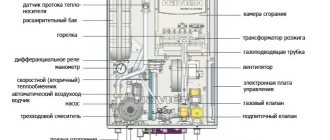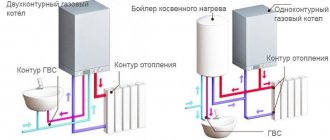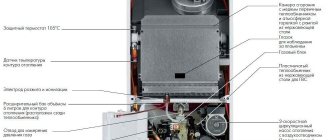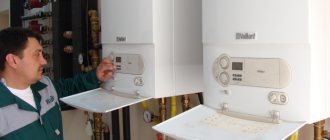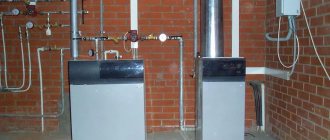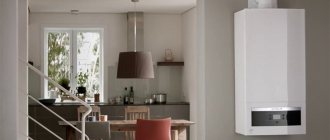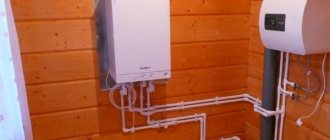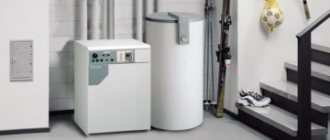The creation of an autonomous heating system begins (or ends) with the installation of a gas boiler.
This procedure is one of the most important and critical stages of work, although it is not fundamentally difficult.
Depending on the design features, additional actions of various types may be required.
This applies to installing your own chimney of one type or another, connecting the boiler to a common chimney, choosing a location and other actions.
In the process of work, many issues arise, both technical and organizational and administrative, which should be discussed separately.
Where should a double-circuit boiler be installed?
Installation of a double-circuit boiler must take into account several requirements:
- The design features of the unit itself are outlined in the user manual.
- Current norms and rules for the installation of gas installations.
- The location of the common chimney, the specific placement of the heating system and other features of the system.
Most double-circuit boilers require connection to a special coaxial type chimney. This is a short unit, arranged like a “pipe in pipe” .
It is passed through the outer wall at the installation point of the unit, connected from the inside to the flue gas outlet, and from the outside it is designed according to its own operational requirements (special cap, mesh fencing or other protection elements).
To install such a chimney you need an external and strong wall . Typically, such units are installed in the kitchen.
If the boiler is of an atmospheric type (with an open combustion chamber), it requires a separate room with an area of at least 8 m2, which has its own window opening.
Floor-standing boilers, as a rule, have large dimensions and weight, so they choose separate rooms in the lower floors of the house.
IMPORTANT!
First of all, you should carefully read the instructions, which clearly describe the conditions of installation work and give instructions for their production.
Tying wall models
From the bottom of the gas double-circuit boiler there are 5 fittings with external threads, designed to connect the following lines (from left to right):
- Supply of heated coolant to the heating system.
- Output of hot water directed to consumers (bathroom, kitchen, etc.).
- The gas pipe connection is located in the middle.
Typical wiring diagram for a double-circuit wall-mounted heat generator - Cold water inlet.
- Return pipeline from the heating network.
The location of the pipes on all suspended units is the same. If you are interested in knowing the reason for installing the fittings in this order, we suggest watching a video about the operating principle of a double-circuit wall-mounted heat generator:
Important note. Five outputs are far from a sign of a boiler with two circuits. Manufacturers of water heating equipment often supply single-circuit heat generators with additional pipes for connecting an indirect heating boiler, placed in the same order.
To connect a gas unit to the heating and electrical lines of a private home with your own hands, prepare the following set of products and materials:
- ball valves with American sizes ½ inch - 3 pcs.;
- the same, with a diameter of ¾” – 4 pcs.;
- mesh filter for water and coolant (also known as a mud filter) – 2 pcs.;
- gas filter;
- expansion tank;
- pipeline fittings – tees and elbows;
- three-core electric cable brand VVG with a cross-section of 2.5 mm²;
- automatic two-pole switch with a rating of 20 amperes.
This list is recommended for wall-mounted boilers of the poorest configuration, equipped with an open combustion chamber. Products of the middle and highest price categories, which are mini-boiler rooms, are equipped with their own gas filter and expansion tank.
It is recommended to compare the dimensions of the standard heat generator tank with the amount of coolant in the heating system, following our instructions. In a situation where the pipeline network is too large and the tank volume is insufficient, an additional membrane tank must be installed.
Connection diagram to the heating system
In reality, wiring a dual-circuit heater is not a problem; there are only a couple of nuances, which we will consider further. You need to understand one thing: a gas boiler is a reliable product; during its entire period of operation it is unlikely to need to be removed and turned off for repairs. Such situations happen 1-2 times during the service life.
A shut-off valve in front of the filter on the heating return is needed to clean it without draining the coolant
Hence the conclusion: shut-off valves are installed primarily to service the heating system. It is unlikely that you will have to cut off and dismantle the heat generator.
Above is a standard connection diagram for a wall-mounted double-circuit boiler, found in every technical data sheet for the product. We expanded it by depicting the wiring and possible consumers. Based on the diagram, perform the tying taking into account the recommendations:
- Place taps with a diameter of ½ inch (DN15) on the fittings for gas, cold and hot water.
- Mount valves of size ¾” (DN20) on pipes with coolant. The third tap is for draining/recharging the system.
- The fittings are screwed down with the American ones.
- Install mud traps at the inlet from the water supply and heating networks in a horizontal position with their nose down, this makes them easier to clean.
- Connect the external expansion tank to the return pipeline using additional fittings to isolate and empty the tank, as illustrated in the diagram.
- Place the drain/fill pipe with a tap at the lowest point of the system.
Advice. It is much more convenient to pack and screw the valves to the fittings before hanging the boiler on the wall. If butterflies or handles interfere with rotation, remove them by unscrewing the nut on the rod. The gas valve is installed through a dielectric gasket.
Two pairs of valves on the heat supply pipes allow you to remove the heat generator and not drain the antifreeze.
For homeowners who fill the system with non-freezing coolant and want to play it safe, an alternative piping scheme for a double-circuit heater is recommended. Thanks to a pair of taps installed on the supply and return, you can dismantle the boiler and service the system without draining the antifreeze.
The scheme is relevant for two- or three-story buildings with water-heated floors and a radiator network, where an additional expansion tank is indispensable. Our expert Vladimir Sukhorukov will reveal the essence of the issue in more detail in a training video:
Connection to the home electrical network
The requirements for connecting electricity are quite simple - you need line protection in the form of a circuit breaker and grounding. If there is no powerful equipment in the furnace room, for example, an electric boiler, then it is not necessary to run a separate cable to the switchboard. Briefly, the requirements are:
- Place the switch in a safe place where water or coolant will not enter in the event of a breakthrough.
- The presence of a wire connected to the ground loop is mandatory. If the cord included with the boiler does not have a third core, connect the conductor to the steel body of the heat generator.
- It is not allowed to use metal heating and water pipes as grounding conductors.
- Lay the cable in a protective corrugated sleeve.
Simplified diagram of connecting to the electrical network of a country house
For reference. European-made turbocharged boilers are sensitive to the correct phase connection. If you confuse the neutral and phase wires, the electronic control unit will not start the boiler.
In areas with unstable mains voltage, it is better to power the unit through a stabilizer that protects the electronics from burnout. Frequent interruptions in the power supply are a reason to purchase and install an uninterruptible power supply unit, otherwise if there is a shutdown you risk being left without heat.
What requirements must be observed during installation?
When performing installation work, you will have to combine two types of requirements:
- Installation conditions set out by the manufacturers.
- Norms and rules for working with gas equipment.
The installation procedure is always described in detail in the instructions. Even if there are no specific requirements, any manufacturer must outline the procedure.
To install wall-mounted units, you must:
- The presence of a strong, ideally load-bearing wall, capable of supporting the weight of the boiler.
- Installation on thin or plasterboard partitions is prohibited.
- Gas boilers with an open burner require a separate room. If installation is in the kitchen, there must be a door and window opening.
Floor-standing boilers have their own requirements:
- The installation is carried out on a layer of asbestos covered with a sheet of metal. This seems unnecessary, but most manufacturers, as well as gas service workers, are unanimous on this.
- The room is separate, ventilated, with access to any point of the boiler.
- The distance from the walls to the surfaces of the unit is at least 0.3 m (for some installations it is greater, please check the instructions).
- The room used as a boiler room should be free of trash, flammable materials, and foreign objects. There should always be quick access to the window, and access to the boiler from all sides should be free.
When mounted in the kitchen, it is allowed to use a quick-detachable decorative box with opening doors.
The gas service requirements are a separate list of conditions. The main one prohibits unauthorized actions with gas equipment . According to it, no one, except gas specialists who have all the required permits and approvals, has the right to install, move or perform other actions with gas appliances.
There is a fine for violation. According to the rules, upon commissioning, the owner undergoes instructions, signs in the log and begins to bear full responsibility. In practice, the situation is somewhat confusing, since these rules were developed for residents of apartment buildings.
Therefore, in most cases, some deviations from the norms are ignored, provided that they do not pose a danger.
In particular, they usually make a compromise - the owner can connect the boiler to the gas supply pipeline, but the connection of this pipeline to the main line is carried out by specialists.
NOTE!
According to Art. 7.19 of the Code of Administrative Offenses of the Russian Federation, unauthorized connection to gas networks is punishable (for individuals) with a fine of 3-4 thousand rubles. Any inspector from the gas service can qualify the connection as unauthorized, so all actions should be agreed upon in advance.
Rules and regulations
If you do not adhere to clear instructions from regional authorities, then at the time of inspection, specialists from the gas distribution company will simply refuse to connect the owner to the unit to the gas pipeline. To avoid such a situation, you need to carefully study the requirements and standards, and then adhere to them during the installation process.
Installation is always carried out only after designing the system; this stage must be taken as seriously as possible in order to avoid big problems in the future.
Do I need to coordinate the installation?
The answer is unequivocal - yes, and to say more, obtaining permission and approval from the authorities takes the lion's share of the time in relation to the entire process. It is better to analyze the algorithm of actions in detail; the first thing the owner of a private house or apartment needs to do is visit the nearest office of a local company to obtain technical specifications.
There he writes an application, which will be considered for some time; it often takes 1-2 weeks to draw up the form, after which the person is given the document in his hands.
As soon as the papers are at the owner’s disposal, it is worth starting to order the development of a project, which includes a piping diagram for a double-circuit boiler and other important installation points.
Such orders can be made at the nearest engineering and design office; specialists with proper education check gas communications and carry out the order, having previously agreed on the terms. When the project is drawn up, it should be sent for consideration to one of the services:
- Gorgaz.
- Raygas.
- Regional gas
- Mingaz.
When purchasing a double-circuit boiler, you should pay attention to the presence of a passport; these documents will also need to be provided.
General requirements for the project
All important points can be found out by reading SNiP 42-01-2002, which contains information regarding the rules for installing a double-circuit boiler. The owner chooses the room in which the equipment will be installed at his own discretion; often in an apartment the unit is installed in the kitchen, but for such a room it is allowed to use devices with a power not exceeding 60 kW.
A separate combustion chamber is provided for units for which this figure reaches 150 kW. There are generally accepted requirements for a room for installing a double-circuit boiler; they look like this:
- Minimum volume values are 7.5 cubic meters. m, and the ceiling height is not lower than 2 m.
- It is prohibited to equip basements, balconies, corridors and bathrooms with devices that operate on gas.
- The walls must be protected from heat; for this purpose, non-combustible materials are used.
- To organize lighting, there is a calculation algorithm: for 10 cubic meters. m. 0.3 windows will be required.
- Connecting to the electrical network requires the use of a grounded cable, as well as for circuit options with a boiler.
- There are separate requirements for the cross-section of the chimney; it must correspond to the power of the equipment.
- The unit is removed from the wall by 0.7 m; there should also be no obstacles in front of it at a distance of 1.25 m.
- From the outlet of the vertical chimney to the device you should retreat no more than 3 meters.
In addition to these rules, special attention is paid to the ventilation of the room; it must be in good working order and function well.
Documentation
To approve the project, you will need to provide a package of collected documents, which include:
- Technical data sheet for the device.
- Operating instructions.
- Certificate of compliance with sanitary and technical requirements.
- Conclusions after passing the examination aimed at inspecting the unit.
If, after performing all the necessary actions, the owner received a written refusal, then employees often make changes that will need to be corrected in order to re-check for compliance with the rules.
Wall-mounted unit installation and connection diagram
First of all, you should carefully study the instructions and prepare all the necessary materials and tools. You can start working only when there are no unclear points left.
If all issues are resolved, proceed with the actual installation.
Let's look at the procedure:
- The boiler delivery set usually includes a template, according to which holes are made on the wall for anchors and a coaxial chimney. The bearing surface is marked on it.
- Using a hammer drill, holes are made for the anchors.
- A mounting plate is attached to the anchor, onto which the boiler is hung. This point cannot be neglected; the plate provides a technological and fire safety gap between the boiler and the wall. Its size must be at least 45 mm.
- The boiler is attached to the plate using standard elements included in the delivery set. All parts must be used and their quantity must not be reduced. There are often situations when the unit is installed in a corner, thereby violating the condition of having a 30-centimeter gap on all sides of the housing. In this case, there is no possibility to secure elements located in the corner. This setting is unacceptable.
- Communications are connected according to the location and purpose of the pipes. As a rule, the extreme left and right are the forward and return lines of the heating system. In the center there is a gas pipe connection pipe. the second ones on the left and right are the hot water pipeline and the cold water supply line. This arrangement is most common, but there may be other options. It is necessary to carefully study the instructions and clarify the location of the pipes of the existing model.
The last step is to connect the boiler to the power supply system. This also has its own characteristics . Most volatile boilers are extremely sensitive to changes in supply voltage.
For proper operation it is necessary to use a power stabilizer.
If this is a standard device produced by the boiler manufacturer as an additional peripheral element, then to connect it you will need to insert a plug into the output of the stabilizer, and connect the device itself to the network.
Other types are connected in a similar way. The main requirement will be the presence of a connected grounding electrode, without which the boiler electronics will constantly generate errors (diagnose a stray flame).
After this, the installation can be considered complete and proceed to the next starting operations.
IMPORTANT!
When connecting pipelines, you can be guided by the diameter of the pipes. On some boiler models it is different, which eliminates the possibility of erroneous connection of communications.
Work principles
The functioning system of a double-circuit gas boiler is simple. In automatic mode, the heating circuit is used. No heat flows into the second circuit, designed to provide hot water: a special valve prevents it. When hot water is turned on, the same valve blocks the flow of heat into the heating circuit. At this moment, the heat supply is directed to the second circuit, due to which the water is heated. Thus, hot water is available as needed, and not constantly, which eliminates excessive consumption of coolant (gas).
Installation of the floor model
Since installation is carried out on the floor, it is necessary to provide it with sufficient strength and rigidity. A cement screed or reinforced concrete slab is required; floor units should not be installed on wooden floors.
There is no direct prohibition on this installation method, but we must remember that wood is prone to warping, drying out, and cracking. Over time, the stability of the boiler may become impaired, which will entail very undesirable consequences.
If possible, a floor-standing boiler should have its own foundation . This is done for powerful and massive models, but you need to take care of flexible adapters, since the position of your own base relative to the general foundation may change, and a significant load will be created on the pipes.
This may result in leaks or destruction of connecting elements.
Procedure:
- Unpack the boiler and check for the presence of the necessary documentation. Make sure the device is complete.
- Place the boiler on a prepared non-combustible base. Carefully align it horizontally. To do this, you need to use all the possibilities - when building the podium, ensure that the horizontal support plane is as level as possible, and use height-adjustable boiler supports. As a last resort, you can place tiles made of non-combustible material under the legs.
- Connect the chimney.
- Connect the direct and return pipelines of the heating system. On the return side (the flow coming from the system to the boiler), it is necessary to install a filter to remove metal particles, scale and other small elements. This will help preserve the boiler heat exchangers and increase its service life.
- Connecting hot and cold water pipelines is no different from connecting a heating system. A filter must also be installed on the cold water supply pipe. Some experts recommend installing shut-off valves; this will help quickly shut off water under pressure.
- Connect the gas pipe through a special shut-off valve. This is mandatory; there must always be a shut-off unit that allows you to quickly stop the fuel supply. You can only connect the gas pipe to the boiler yourself. Only a gas service specialist who has a permit and all the necessary documents has the right to connect to the main line. He will also check the quality of the connections using a soap solution.
- The power connection should be made using a special socket with a grounding electrode. It is strongly recommended to use a voltage stabilizer so as not to spend money on expensive repairs to the boiler electronics.
The last step will be another thorough check of the correct connection, strength and reliability of the pipeline connection.
After this, you can begin setting up and launching for the first time.
Installation of a floor-standing device
If a double-circuit heat generator requires power supply, then it is connected in the same way as a wall-mounted “colleague”. The energy-independent device has a built-in copper or stainless steel coil for heating water. Apart from the burner, automation and heat exchanger, nothing is supplied with this equipment.
To install a non-volatile unit, you will need a set from the previous list plus the following system elements:
- safety group, the safety valve of which is designed for the operating pressure of the boiler (data is in the passport);
- expansion tank with a volume of 10% of the total amount of coolant;
- circulation pump.
A safety group is always installed on the supply pipe next to the heating device to protect the most expensive part of the system from destruction during a sudden pressure surge.
The distance from the boiler to the device should be no more than 50 cm. Taps and tees must not be installed on the pipe section between the heater and the element; the line must be left clean
If the floor-standing device is connected to a gravity system, only an open-type expansion tank with overflow is installed. The pump and safety group are excluded from the diagram.
In this situation, pipes with a diameter of 40 mm or more are needed, which are laid at a slope of 5 mm for each linear meter of the main line. The heat generator remains at the lowest point, the tank is located at the highest.
If electricity is connected, it is permissible to organize forced circulation using a pump. In this case, its installation is carried out through a bypass
Most modern systems include a circulation pump , which is efficient but dependent on electricity. When the lights are turned off, heating and water heating are turned off. It is wise to organize an alternative natural circulation method for force majeure.
How to connect a boiler
There are different options for installing a boiler, depending on its design.
Can be used:
- Indirect heating boiler with heat exchanger.
- Layer heating boiler.
- Electric storage boiler.
The most accessible and inexpensive option is an external stratified heating boiler. It is not equipped with its own heat exchanger, so it is inexpensive and easy to operate.
Any type of connection is made according to the user instructions. The process is not difficult at all, you just need to connect the boiler inlet and outlet to the corresponding boiler pipes, and also connect the hot water collection line to its outlet.
Depending on the design, a connection to a break in the heating circuit supply line, or a direct DHW outlet from the boiler can be used to accumulate hot water in a container.
Additional installation recommendations
strictly forbidden to reduce the diameter of the internal cross-section of the connected pipes . The optimal value for a boiler up to 28 kW is at least 20 mm for heating and at least 15 mm for water supply.
If the boiler is not included in the circuit, it is wiser to install the device closer to the hot water tap, which is often used.
In the case of connecting underfloor heating, the system is complemented by a separate branch with a collector and a circulation pump.
Installing a coaxial pipe step by step
The coaxial chimney is installed in close proximity to the boiler, along the axis of the chimney outlet. A hole must be made in the outer wall, 5-10 mm larger in diameter than the external size of the chimney.
This is done using a special diamond crown, or with a conventional hammer drill (which takes a long time and will require additional plastering and finishing work).
After that:
- The base of the coaxial pipe is connected to the boiler chimney outlet.
- The first chimney segment is installed. Immediately securely fixed with all appropriate fasteners.
- After it, the second section of the chimney is connected, the whole procedure is repeated. All pipe sections required by installation conditions are connected in a similar way.
- The joints of the pipe and the gap between the chimney and the wall are carefully sealed.
- The performance of the chimney is tested.
A through hole in the wall is made with a slight inward slope so that condensate can drain into a special container. If this is not done, the chimney outlet will freeze in the winter.
Boiler connection features
Before you begin installing the boiler, it is worth considering all its operating features so that you can decide whether the gamble is worth the candle. There are some nuances, and it is also necessary to do the tying correctly, but more on that below. Among the things you should consider:
- To install gas equipment, you will have to provide good ventilation to the room where you plan to do it. Otherwise, combustion products will quickly clog the chimney, which may not end well.
- Wall-mounted models must be layered with fire-resistant materials, because the boiler also heats up and can easily burn a regular wooden wall.
- The space around the heating, as mentioned above, should be cleared in order to facilitate its maintenance and increase the safety of the installation as a whole.
- It is worth installing gas meters in the boiler room; they will help you monitor the operation of the ventilation and, if something happens, quickly turn off the autonomous heating.
How to start the boiler after installation
The first launch is carried out in stages:
- The system is slowly filled with water. This is necessary so that all the air has time to escape. Fill until the pressure is 1-1.5 Bar.
- Check the condition of all connections, look for possible leaks.
- After this, gas is supplied and the boiler is tested. These actions are performed by technicians from the service center. They determine what adjustments need to be made to the factory settings, determine the upper and lower limits of temperature conditions, and perform other necessary actions. Starting the boiler on your own is not recommended even for experienced people, and this procedure is strictly prohibited overnight.
Parallel operation of wood and gas boilers
This option for heating a house from two boilers provides for their separate connection to the circulation system. Each heat source must have its own circulation pump installed at the return line inlet. There is no need to do this for a wall-mounted gas boiler; the pump is already installed by the manufacturer. If solid fuel burns out, the temperature of the coolant will decrease and the gas boiler will automatically turn on.
An important design point is the piping of the solid fuel boiler with metal pipes and the presence of an emergency discharge device with the simultaneous supply of cold water to the return line.
1 scheme (open and closed systems)
This method is convenient because the liquids of the two systems do not mix. This allows the use of different coolants.
Advantages and disadvantages
| pros | Minuses |
| Possibility to use different coolants | A large number of additional equipment |
| Safe operation, the reserve tank will release excess water in case of boiling | Efficiency is lower due to excess water in the system |
| Possibility of use without additional automation |
2 scheme, two closed systems
It uses a closed system, which eliminates the need for a heat accumulator. Control is carried out by thermostats and three-way sensors. Operational safety is ensured by automation.
Here we use the battery for excess heat. Thus, we increase the efficiency of the system and eliminate the need for temperature sensors and automation.
Heat supply via 3-way valve
Each boiler must be equipped with its own circulation pump, and another pump will be required to ensure circulation through the heating system devices. An automatic air vent should be installed at the top point of the hydraulic separator, and a tap for emergency drainage of water at the bottom.
System with a heat accumulator, why is it used?
The heat generated by the wood-burning boiler enters this container. From not, through a coil, heat exchanger or without them, into a gas boiler. The automation of the second understands that the water has the required temperature and turns off the gas. This will continue as long as there is enough temperature in the heat accumulator.
A heat accumulator or a heat-insulated container with a built-in coil, designed to accumulate heated coolant and supply it to the heating system. In this scheme, the gas boiler, heating devices and battery are connected by pipelines into one closed system. The solid fuel boiler is connected to the built-in battery coil and thus heats the coolant in a closed system. The organization of heating operation in this scheme occurs in the following order:
- In a solid fuel boiler, wood burns and the coolant is heated from the coil in the container;
- solid fuel has burned out, the coolant has cooled;
- the gas boiler turns on automatically;
- the firewood is laid again and the solid fuel boiler is ignited;
- The temperature of the water in the battery rises to the same temperature as that set on the gas boiler, which stops automatically.
This scheme requires the greatest costs for the purchase of materials and equipment, but has a number of advantages:
- the solid fuel boiler can operate in an open circuit;
- highest level of security;
- no need to constantly replenish the firebox with wood or coal;
- coolant circulation through a closed system;
- the possibility of simultaneous operation of two boilers simultaneously and each separately.
Additional costs include the purchase of an accumulator tank with a coil, two expansion tanks and an additional circulation pump.
calculate the required volume of container
Main types
Gas boilers are classified according to various criteria: purpose, power produced, type of draft and installation method. Single-circuit boilers are installed exclusively for heating the house, while double-circuit boilers allow not only to warm up the premises, but also to provide the house with water with the possibility of heating it.
Low-power boilers are regulated according to a single-stage principle, medium-capacity units are regulated according to a two-stage principle. High-performance boilers usually provide modulated power control.
Closed-type boilers operate on ventilation draft. There are also gas boilers with natural draft - open type, or atmospheric.
Installation of gas boilers in a private house is carried out either by mounting on the wall or on the floor. In the first case, copper heat exchangers are used, and in the second, cast iron or steel.
The optimal solution for use in a private home is considered to be a flow-through double-circuit boiler with a boiler operating on automation. It provides heating of rooms in the cold season and heating of water for cooking, washing dishes, and taking a shower.
An automatic system, which includes a double thermostat and a microprocessor, greatly simplifies the process of adjusting the equipment, allows you to monitor the temperature indoors and outdoors, set a program to reduce heating to a minimum if there are no people in the house (for example, in the daytime, when everyone has gone to work). work).
Installing a boiler with fully automatic control will help you save from 30% to 70% of fuel compared to equipment with manual or semi-automatic control.
At the same time, in the absence of electricity, an automatic home boiler room will not be able to provide full heating of the house, so when installing the boiler, force majeure situations must also be taken into account.
When purchasing a gas boiler, be sure to check the availability of the certificate and equipment. If necessary, purchase additional fasteners for mounting the unit on a wall.
Electric and diesel heat generators
Connecting a diesel fuel boiler to the radiator system is identical to piping gas-using installations. Reason: a diesel unit operates on a similar principle - an electronically controlled burner heats the heat exchanger with a flame, maintaining the set coolant temperature.
Electric boilers, in which the water is heated by heating elements, an induction core, or through the electrolysis of salts, are also connected directly to the heating. Automation located in an electrical cabinet connected to the network according to the electrical diagram provided is responsible for maintaining temperature and safety. Other connection options are shown in a separate publication on the installation of electric heating boilers.
Wall-mounted mini-boiler rooms equipped with tubular heaters are intended only for closed heating systems. To work with gravity wiring, you will need an electrode or induction unit, which is tied according to the standard scheme:
If you look at it, there is no need for a bypass here - the boiler will not work without electricity either
Requirements for a boiler room with a gas boiler
Much depends on the performance of the boiler: if it reaches more than 30 kilowatts, then there is a need for a separate room. It is on the basis of the provisions of the 'Building Codes and Rules' that specific instructions are built and created for the arrangement of a boiler house specialized in heating for the combustion of products.
- It is possible to place a boiler room in attics, basements, that is, in special rooms of houses. But it is worth considering that a cleared corridor and sufficient illumination are required.
- The installed volume is at least 14 square meters, taking into account a power of 30-60 kilowatts and above 15 square meters intended for boilers of higher productivity.
- Comfortable and unhindered access to the device.
- Covering the walls with non-flammable material.
- Providing a ventilation process with three times the amount of air exchange.
Single-pipe scheme with Leningrad
Deploying a gravitational circuit is a difficult task. If the boiler is used in a private house, an apartment with one floor, the number of radiators does not exceed 5-6 (the exact value depends on the power of the boiler), it is possible to provide a single-pipe Leningrad system.
The scheme, called Leningrad, is an installation method when the main line is located at floor level, exactly along the surface. The batteries are installed with the bottom connection.
Located horizontally. The only vertical element of the circuit is the accelerating riser. It is removed from the boiler, bent, and connected to the tank.
Installation of a horizontal pipeline for a natural cycle is carried out at an angle. The angle rarely exceeds 30 degrees.
Leningrad wiring in one pipe works in small rooms.
Results
Installing gas equipment is a complex and rather lengthy process that requires care, accuracy and a clear understanding of the standards that must be observed during installation.
Of course, the simplest and most reliable solution would be to install the boiler with the help of a specialist, since he will be able to correctly calculate the installation location in accordance with the requirements, and you will also be sure that all connections are tight. In this case, you should not skimp on the services of a specialist if you doubt your own abilities, since every mistake in such a serious event can be fatal.
If installed correctly, a wall-mounted gas boiler will be able to keep you and your loved ones warm for many years to come.
